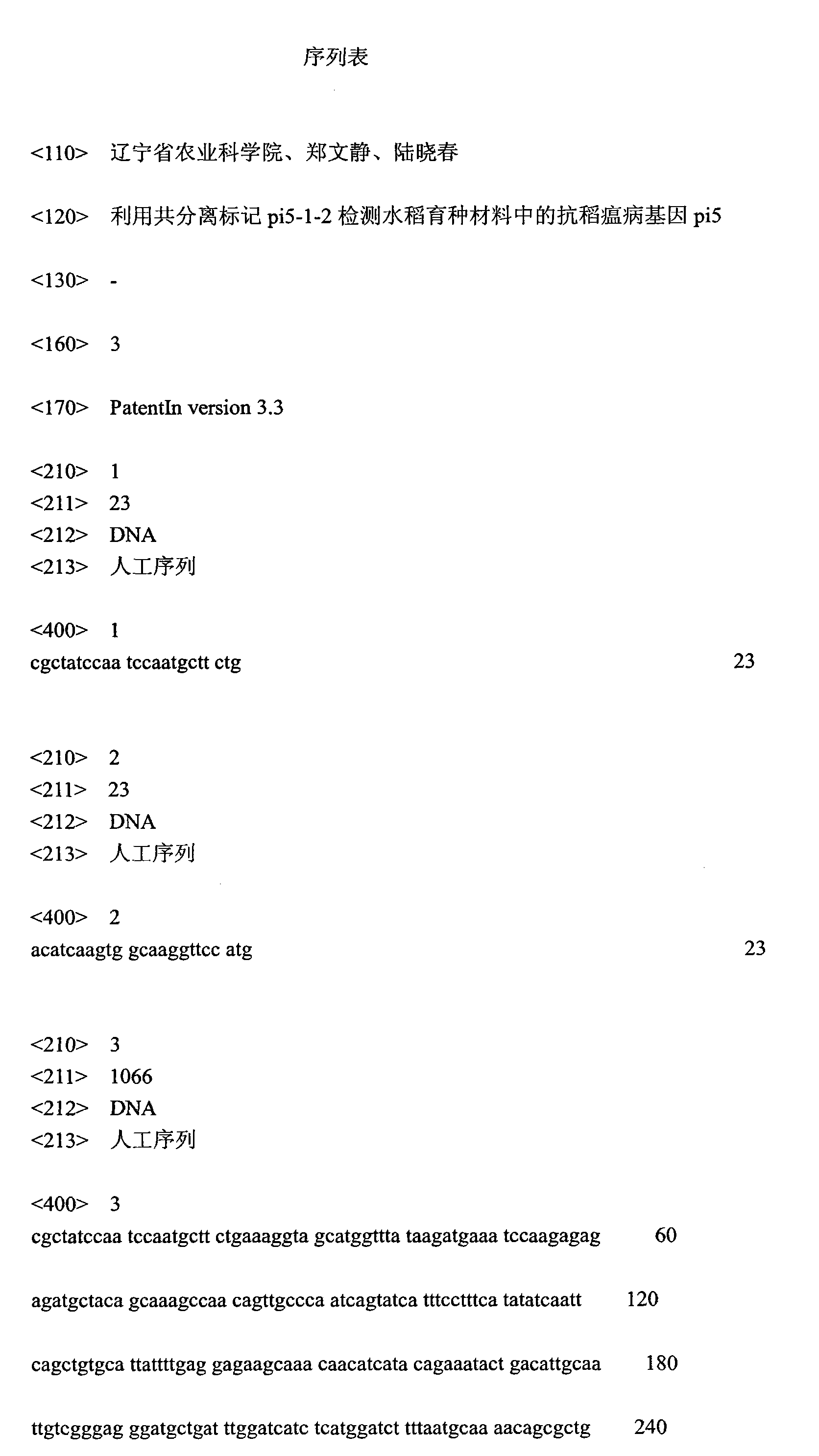Method for detecting anti-pyricularia grisea cav. gene pi5 in rice breeding materials by utilizing co-segregation marker pi5-1-2
A rice blast resistance gene and rice blast resistance technology, applied in the field of molecular biology, can solve the problems of low accuracy, heavy workload, blindness, etc.
- Summary
- Abstract
- Description
- Claims
- Application Information
AI Technical Summary
Problems solved by technology
Method used
Image
Examples
Embodiment 1
[0019] Example 1: DNA extraction, PCR amplification and electrophoresis analysis
[0020] 1. DNA extraction (CTAB method):
[0021] Weigh 0.1-0.2 g of rice leaves and cut them into 1 cm lengths, grind them in liquid nitrogen, and after the liquid nitrogen has evaporated (note: do not let the samples melt), quickly transfer them to extracts containing 65°C preheated (1M Tris pH8.0, 100mM; 5M NaCl, 1.0M; 0.5M EDTA, 20mM; 10% CTAB, 2.0%) in a 400μL centrifuge tube. Shake gently.
[0022] 60~65℃ water bath for 30~60 minutes, shake gently every 10 minutes evenly.
[0023] Add an equal volume of chloroform / isoamyl alcohol (24:1), and shake gently to form an emulsion.
[0024] At room temperature (the temperature is not lower than 15° C.), centrifuge at 12000 r / min for 5 minutes, and take the supernatant.
[0025] Carefully extract 200 μL of the supernatant with a large-hole tip, add pre-cooled 2 times the volume of absolute ethanol (or an equal volume of isoamyl alcohol), place ...
Embodiment 2
[0036] Example 2: Detection of pi5-1-2 markers in pi5 donor varieties and monogenic lines.
[0037] Using rice blast resistance gene Pi5 donor variety RIL260, pi5 monogenic line and 5 highly susceptible rice varieties (Lijiang Xintuan Heigu; Liaoyan 241; Yanfeng 47; Liaoxing 1; Nipponbare) as test materials, planted in In the greenhouse, the blast fungus ZA9, ZA33, ZB1 and ZB17 popular in the Liaoning area were transplanted on the oatmeal tomato juice agar medium, and cultured at 25-27°C for 5-7 days. After wiping off the aerial hyphae with cotton swabs and cultivating them with moisture, the blast fungus will produce a large number of spores. When the rice seedlings of 7 varieties grow to 5 leaves and 1 heart, the conidia of each bacterial strain cultivated above are washed with 120ml sterile water respectively, filtered with double-layer gauze and packed into a triangular flask, and the spore suspension (concentration There are about 20 spores under the microscope field of ...
Embodiment 3
[0053] Example 3: Using the molecular marker pi5-1-2 to detect whether the breeding parent material contains the rice blast resistance gene pi5
[0054] Using rice blast resistance gene Pi5 donor varieties RIL260, pi5 single-gene lines (introduced from IRRI) and 16 rice varieties as test materials, they were normally planted in the field, and DNA was extracted according to the method described in Example 1 at the seedling stage. NO: 1 and SEQ ID NO: 2 are primers for PCR amplification, and the amplification results of 18 varieties are as follows figure 2 As shown, in addition to the rice blast resistance gene Pi5 donor variety RIL260 and the pi5 single-gene line (introduced from IRRI), the 13th variety Liaonong 979 also amplified specific products consistent with the donor variety and the single-gene line. Sequencing results showed that the sequence of the amplified product sequence shown in SEQ ID NO: 3 was consistent. The results of inoculation identification showed that L...
PUM
| Property | Measurement | Unit |
|---|---|---|
| diameter | aaaaa | aaaaa |
Abstract
Description
Claims
Application Information
 Login to View More
Login to View More - R&D
- Intellectual Property
- Life Sciences
- Materials
- Tech Scout
- Unparalleled Data Quality
- Higher Quality Content
- 60% Fewer Hallucinations
Browse by: Latest US Patents, China's latest patents, Technical Efficacy Thesaurus, Application Domain, Technology Topic, Popular Technical Reports.
© 2025 PatSnap. All rights reserved.Legal|Privacy policy|Modern Slavery Act Transparency Statement|Sitemap|About US| Contact US: help@patsnap.com



